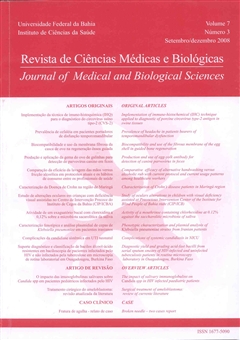Production and use of egg-yolk antibody for detection of canine parvovirus in feces
DOI:
https://doi.org/10.9771/cmbio.v7i3.4463Keywords:
Canine parvovirus - Diagnosis - Egg yolk antibody- ELISA, indirect, Canine parvovirus - Diagnosis - HA-HIAbstract
Canine parvovirus (CPV), cause an intestinal disease characterized by bloody diarrhea, is often fatal in puppies. The virus is transmitted by contact with infected dogs or their feces. The virus is very stable in the environment and may survive for several months in contaminated areas. The CPV attacks the rapidly diving cells of the bone marrow and the small intestine. Several laboratory tests have been developed and are available for specific viral diagnosis. Where facilities are available, rapid diagnosis can be made by electron microscopy (EM) of fecal material from cases with typical signs of disease. The virus also can be isolated in several feline and canine cell lines such as canine and feline kidney cells, but isolation is seldom used in practice since cell cultures are required and at least 1 week for results is required. Fecal hemagglutination-hemagglutination (HA-HI) tests have provided a simple and rapid method for detecting virus in fecal and tissue samples and are employed by several diagnostic laboratories, however the HA test is less sensitive than EM or enzyme-linked immunoassays (ELISA). In this work, the laying chickens are immunized with the canine parvovirus strain Cornell 780916-80 and the egg yolk antibody (IgY) isolated and characterized by indirect ELISA to detect canine parvovirus in feces.Downloads
Download data is not yet available.
Downloads
Published
2008-02-29
How to Cite
Guimarães, M. C. C., Amaral, L. G., Borges, F. V., Vieira, H. P. L., Shimoya, A., Matta, C. G. F., & Matta, M. F. de R. (2008). Production and use of egg-yolk antibody for detection of canine parvovirus in feces. Journal of Medical and Biological Sciences, 7(3), 241–248. https://doi.org/10.9771/cmbio.v7i3.4463
Issue
Section
ORIGINAL ARTICLES
License
The Journal of Medical and Biological Sciences reserves all copyrights of published works, including translations, allowing, however, their subsequent reproduction as transcription, with proper citation of source, through the Creative Commons license. The periodical has free and free access.


